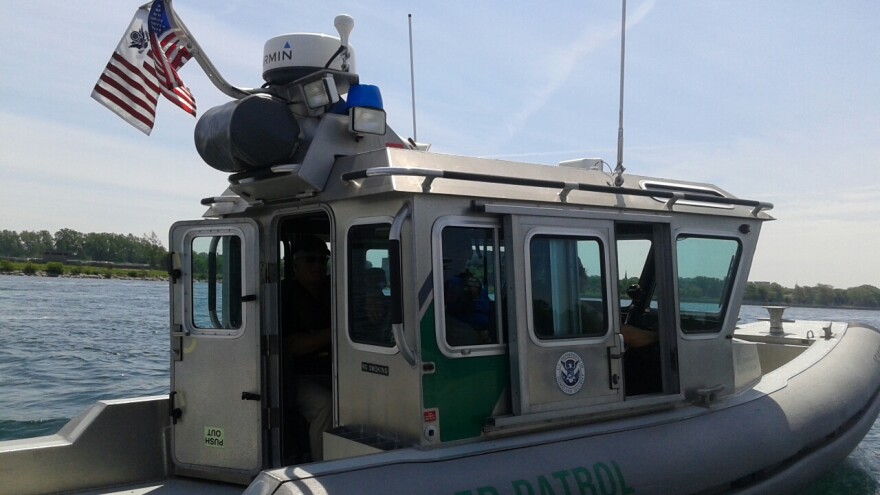I used to cross the US-Canada border so often, it felt like “Anything to declare, ma’am?” was playing on repeat in my mind.
My all-time favorite encounter was on a bus trip with my sister from Toronto to Cleveland, when one of the Customs guys in blue noticed my Jamaican heritage listed in my Canadian passport and asked, “Are you bringing over any ackees?”
(Video after the jump.)
No, I most certainly was not travelling from Canada to the Midwestern United States, with Jamaica’s national fruit in my suitcase. And at the time I thought, “Why would I be?” I exchanged glances with my sister then asked him to repeat the question - just to be sure I heard his ignorance correctly.
Let’s face it. We’re glad they’re protecting the borders but that doesn’t stop us from getting defensive when they’re doing their job.
But bear in mind U.S. Customs and Border Protection (CBP) officers, have roughly less than a minute at the ports of entry, to separate the bad from the good.
However, this challenge goes up a notch for the 21,000 U.S. Border Patrol agents in green, who secure the 7,000 miles of border the United States shares with Canada and Mexico. That includes agents patrolling land, rivers, lakes and coastal waters around the country.
“You don’t want to try and cross the Niagara River at one in the morning with a life vest and a plain old household flashlight. You’re not going to make it. We’ll be out here trying to grab you,” Vessel Commander James Morgan explained at a recent behind-the-scenes event hosted by the CPB at their Buffalo station.
Recon III
The Border agents identify and prevent the trafficking of humans and contraband and work alongside other law enforcement agencies to make way for legal trade.

“There’s a lot of clutter that happens during the summer. We see a lot of boats for different reasons, for fishing or just for leisure. And it’s hard to tell who’s doing something illegal or something suspicious to someone who’s just fishing and doing what people normally do,” says Senior Patrol Agent Dean Mandel.
Modern gadgets like infrared cameras, sensors, and other handheld technology aid the eyes and ears of agents. The Recon 3 is a long-range thermal binocular and camera with geolocation, which comes in handy for night surveillance.
This high-tech tool can be set up on its own in any remote location and works in coordination with a small monitor inside the agent’s scope truck. The monitor displays a map of the area with dots marking where the Recon 3 detects movement far out in the waterways. If an agent spots potential trouble, he can radio other agents to investigate by sharing GPS coordinates.
Sign Cutting
Though they can be as tech-geeky as the next person, Border Patrol agents take pride in their ability to also get out on foot. At the southern border, they have mastered the technique of sign cutting. The “signs” in question are the physical evidence of disturbance by people, animals, or objects. Think American Indian trackers in the old cowboy western movies.
"You don't want to try and cross the Niagara River at one in the morning with a life vest and a plain old household flashlight. You're not going to make it. We'll be out here trying to grab you."
“This is where technology meets the old school skills, where you can really start tracking people. You see different footprints and different directions. If this was a border road, you might know that someone has crossed it,” says Mandel.
Signs are one of the most important ways agents know that desert-crossing immigrants or drug smugglers have passed by. Quarterly, on-the-job training allows agents to effectively communicate with each other according to the tire tracks or type of footprint they encounter. Signs can also tell agents things like which way the person is headed, or how fast or slow they are travelling.
“The hard angles tell you if it’s fresh or not,” adds Mandel.
Agents also learn how to identify less noticeable signs: kicked dirt, dark soil, broken plant limbs, and bits of clothing. They say smugglers even use branches to brush away and cover their tracks, something a junior Border Patrol agent might miss along the way.
In The News
Behind-the-scenes events like this are no doubt designed to offset some recent negative press that Customs and Border Patrol has received.
In 2013 a report by the New York University School of Law Immigrant Rights Clinic and the Families for Freedom group reported that border patrol agents in the Rochester and Buffalo corridor had been offered cash and other incentives to meet arrest targets. The same report found that at least 300 people who were legally allowed in the United States were arrested and detained by agents between 2006 and 2011. These included U.S. citizens, tourists and student visa holders.

A recent incident where a SUNY criminal justice student was tased by Border Patrol agents during a roadside stop in the North Country shows our relationship with the officers who guard the border can be, well, ambivalent.
And from the other side, the men and women who suit up on a daily basis face real and often unknown risks. The U.S. Border Patrol has lost 119 officers in the line of duty during the 20th century, more than any other federal law enforcement agency over the same period.
“[My hope is] we’re all safe at the end of the day. That I can go home to my wife and kids is the biggest reward,” says Mandel.
Watch as Agent Mandel demonstrates the traditional technique of sign cutting.
https://www.youtube.com/watch?v=CVuSHxuxh_c




